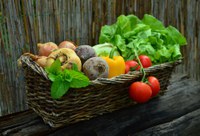Prairie Fare: What you eat may affect your vision
(Click an image below to view a high-resolution image that can be downloaded)
I noticed our backyard was starting to sprout green grass after some April showers. Some of my perennial plants are beginning to peek through the mulch in my flowerbed. I look forward to the pink, red and yellow tulips of spring.
Springtime is a favorite season for many as the colorful blossoming bulbs begin to appear. Of course, growing grass means mowing, but that activity promotes physical activity.
I am thankful about being able to enjoy the colors of spring and our upcoming summer. Unfortunately, not everyone has the ability to see well. As we grow older, we have greater risk of developing age-related vision issues. Regular vision screening can help prevent vision loss.
“Three of my friends have macular degeneration,” I overheard someone say the other day.
My ears always perk when I hear about diseases with potential nutrition connections.
Macular degeneration, also called age-related macular degeneration or AMD, is a potential cause of blindness if untreated.
The macula or “yellow spot” is contained within the retina of the eye. It gives us the ability to have central vision and see color, and it allows our eyes and brain to translate light into images.
The macula is about the size of the letter O in 12-point font used commonly in newspapers or magazines. Despite its small size, the macula plays an all-important role.
If the macula is damaged, we may lose our ability to do many tasks of daily life that require sharp vision. Those activities include driving, seeing faces in front of us and reading smaller print.
The macula is made up of lutein and zeaxanthin, which are two natural colorants, or pigments. They are in the carotenoid family of pigments.
We need to “feed” the macula by eating colorful fruits, vegetables and egg yolks.
Although you may think of carrots as being good for your eyes, other foods have larger amounts of these pigments to nourish the macula.
Corn, orange bell peppers, kale, collard greens and spinach are among the best sources of zeaxanthin. Egg yolks, dark leafy greens, corn and peas are among the best sources of lutein.
Remember that fresh, frozen, and canned vegetables and fruits are all good sources of these nutrients and provide abundant carotenoids.
Are you eating these foods and other colorful fruits and vegetables regularly? Most adults need about 4 to 5 cups of fruits and vegetables daily.
What about carrots and our eyes? Keep eating carrots, too, for lots of reasons. Carrots are rich in carotenoid pigments, and they help protect our night vision, but they do not contain the pigments in the macula.
Green vegetables such as broccoli, orange and red fruits, and vegetables such as pumpkin and tomatoes are all good sources of healthful carotenoids.
Dietary supplements are another option, but think of food first. Fruits and vegetables contain a variety of health-promoting phytochemicals (plant chemicals) with health-promoting properties.
As the sun grows brighter and the weather warms, protect your eyes. Wear high-quality sun glasses and a wide-brimmed hat during outdoor activities such as picnics, gardening, walking and golf.
Be sure to have regular vision screening with your eye care professional. Many eye health professionals recommend a vision exam with dilated eyes for everyone over 50 years, or as recommended by your eye care professional.
Enjoy the colors of nature outdoors and on your plate.
Have you tried making ranch dressing from scratch? You might have all the makings in your cupboard and refrigerator. This can be used as a dip for colorful veggies or a dressing for your favorite salad greens to help nourish your eyes and your body.
Ranch Dressing Master Mix
2 tablespoons dried parsley flakes
5 tablespoons dried minced onions
1 tablespoon salt
1 teaspoon garlic powder
Mix together and store in an airtight container until ready to use. Label, date and store in a cool, dry place. Use within three months.
To prepare ranch salad dressing, mix together:
1 cup low-fat mayonnaise
1 cup low-fat buttermilk
3 tablespoons dry ranch mix
Chill salad dressing for a couple of hours in the refrigerator before serving to blend flavors. Shake and serve.
(Julie Garden-Robinson, Ph.D., R.D., L.R.D., is a North Dakota State University Extension food and nutrition specialist and professor in the Department of Health, Nutrition and Exercise Sciences.)
NDSU Agriculture Communication – April 11, 2024
Source: Julie Garden-Robinson, 701-231-7187, julie.garden-robinson@ndsu.edu
Editor: Elizabeth Cronin, 701-231-7006, elizabeth.cronin@ndsu.edu




